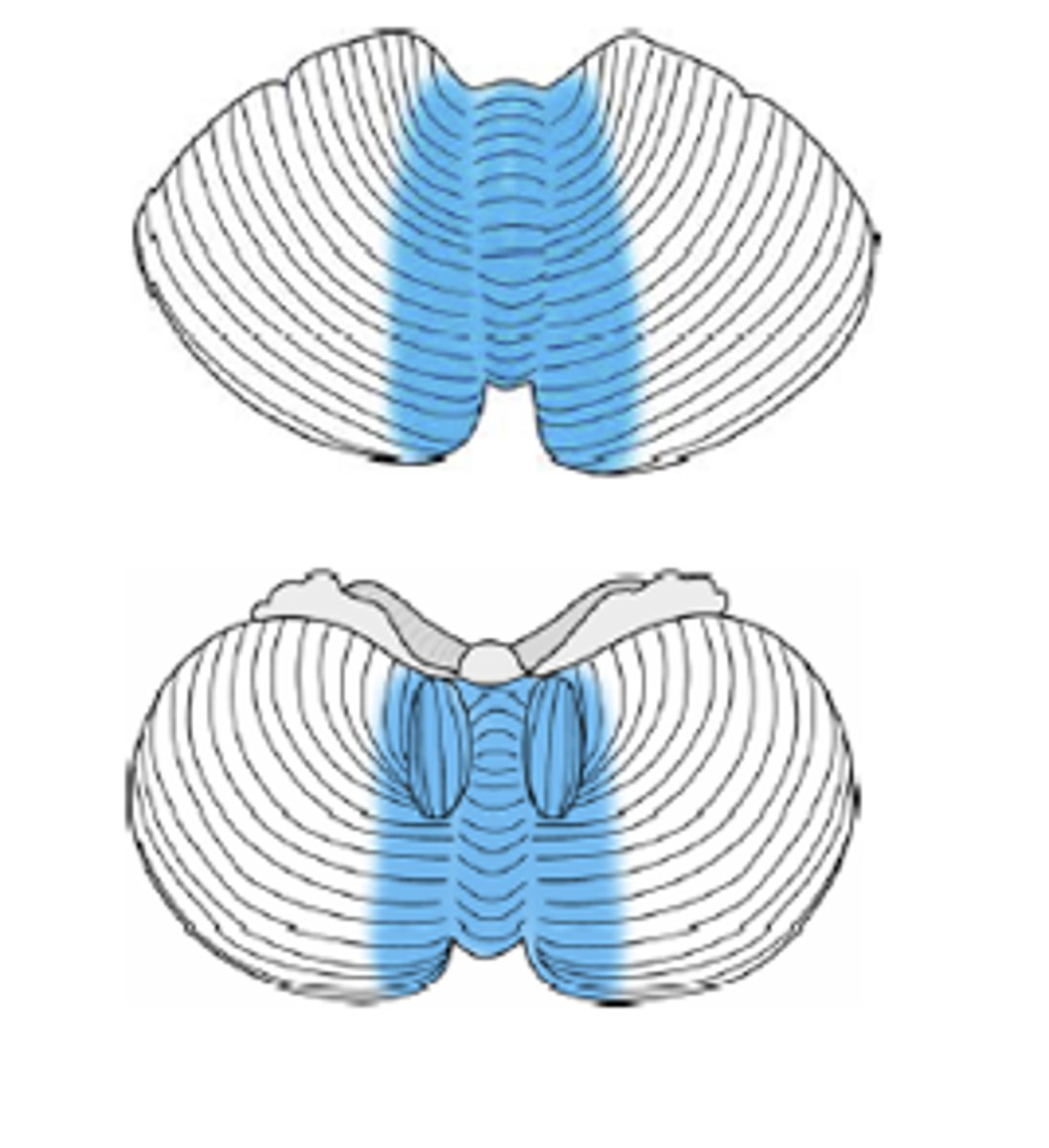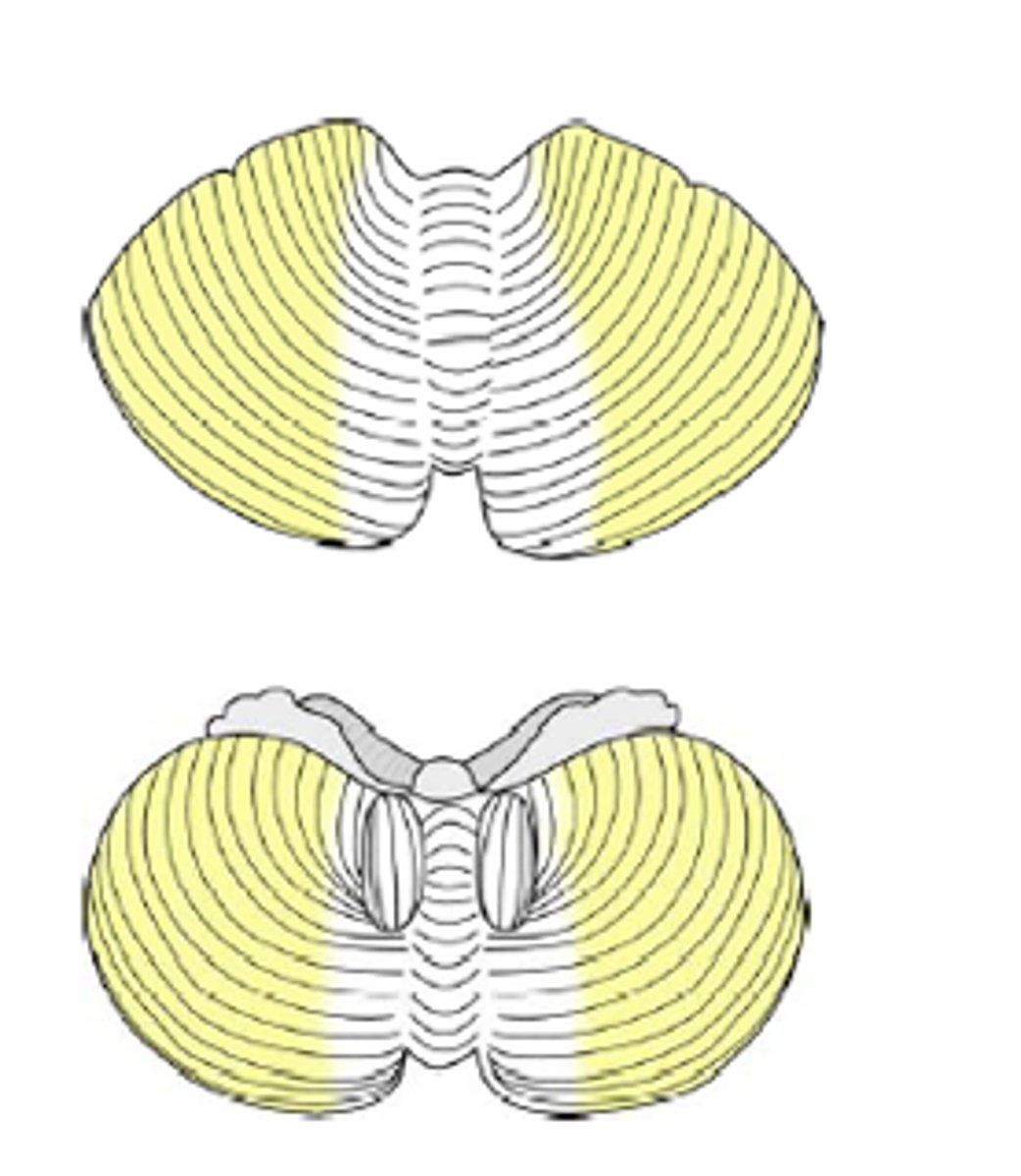OTM 507 Cerebellum Week 6
1/16
There's no tags or description
Looks like no tags are added yet.
Name | Mastery | Learn | Test | Matching | Spaced |
|---|
No study sessions yet.
17 Terms
Cerebellum ("little brain")
Coordinates movement: adjusts intended movements with actual movements
- maintains postural control and muscle tension
- controls timing and rhythm of movements, learning?
- synchronization of movements
- use sensory info to make changes
Necessary for smooth accurate movements including eye movements for maintaining balance
- all functions are nonconscious
Damage here = poor coordination of movement and postural control
Feedback loop: ensures movement is smooth and precise
- sends signals to the thalamus and brainstem
- receives signals from the spinal cord and brainstem
Anterior (superior) lobe
Receives input from the spinal cord
- mediates unconscious proprioception
Lobe of the cerebellum
Posterior (inferior) lobe
Receives input from the cortex and brainstem for movement coordination
Lobe of the cerebellum
Flocculonodular lobe
Sends info to vestibular nuclei and modulates equilibrium
AKA vestibulocerebellum
Lobe of the cerebellum
Spinocerebellum
Extensive connection with the spinal cord
- coordinates gross limb movements
- functional name for the vermis

Cerebrocerebellum
Named for connection to the cerebral cortex
- coordinates precise (fine motor) and distal limb voluntary movements
- functional name for the lateral hemispheres

Spinocerebellar Tract
Info in the SC destined for the cerebellum
- unconscious proprioception
- anterior and posterior (lower limbs) pathways
Intended for unconscious movements to occur
Automatic movements
Info from muscle spindles
Anterior pathway
- transmits proprioceptive info from lover limbs and trunk
- crosses the SC then again in pons (ipsilateral)
Posterior (dorsal) pathway
- proprioceptive info from the lower extremity
- ascends ipsilaterally with no crossing
Cuneocerebellar tract
Proprioceptive info from the upper extremities
Ascends ipsilaterally in the dorsal column
Spinocerebellar Ataxia
Group of degenerative disorders that cause atrophy of the spinocerebellar tracts and cerebellum
- depending on the type, multiple structures can be damaged
Etiology/Prognosis
- hereditary
- degenerative
Symptoms/Signs
- problems with coordination and balance
- uncoordinated walk
- poor hand-eye coordination
- abnormal speech
- involuntary eye movement
- vision problems
- difficulty processing, learning, and remembering info
- usually wheelchair dependent 10-15 yrs from onset of symptoms
Multiple system atrophy
Etiology/Prognosis
- degenerative, inherited
- adult onset 50-60
Symptoms/Signs
- impaired movement and coordination
-- unsteady gait and loss of balance
- slurred, slow, or low volume speech (dysarthria)
- visual disturbances
--- blurred or double vision and difficulty focusing eyes
- difficulty swallowing (dysphagia) or chewing
- autonomic function changes
Ataxia (cerebellar clinical sign)
Movement disorder common to all lesion of the cerebellum
- voluntary, normal-strength, jerky and inaccurate movements that are not associated with tight muscles or weakness
- can be caused by sensory deficits and not direct injury to the cerebellum or spinocerebellar tract ---> need to test sensory to rule out
To test which type
- Romberg
- vibration
- touch
observation, tone, coordination, balance, sensation?
What 5 neuro tests should you perform to test the cerebellum?
Romberg
Tests for proprioception
Cerebellar Ataxia = positive with or without vision
Sensory Ataxia = positive only with eyes closed
Observation (neuro testing)
Part of the neuro exam for the cerebellum
Looking for involuntary movements
- trunk, extremities, head/neck
Muscle function screen (neuro testing)
Part of the neuro exam for the cerebellum
- Active ROM upper and lower extremities
- Passive ROM upper and lower extremities
--- looking for any spasticity, rigidity, or flaccid
--- symmetrical?, muscle strength
Coordination (neruo testing)
Part of the neuro exam for the cerebellum
Finger to nose
finger to finger
Heel to shin
Rapid alternating movements
- dysdiadochokinesia
Hand, finger, foot tap
Balance (neuro testing)
Part of the neuro exam for the cerebellum
Gait observation
- ataxia, arm swing
Tandem walk/stance
Heel (dorsiflexion) and toe (plantarflexion) walk